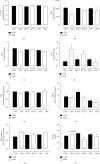Prolonged Diuretic and Renoprotective Effects of a Xanthone Obtained from Garcinia achachairu Rusby in Normotensive and Hypertensive Rats
- PMID: 33995544
- PMCID: PMC8081593
- DOI: 10.1155/2021/5510053
Prolonged Diuretic and Renoprotective Effects of a Xanthone Obtained from Garcinia achachairu Rusby in Normotensive and Hypertensive Rats
Abstract
The previous study showed that 1,5,8-trihydroxy-4',5'-dimethyl-2H-pyrano(2,3 : 3,2)-4-(3-methylbut-2-enyl) xanthone (TDP) obtained from Garcinia achachairu Rusby (Clusiaceae) branches induces acute diuresis in normotensive (NTR) and spontaneously hypertensive rats (SHR) after 8 h of the experiment. In complementarity, the present study evaluated the prolonged diuretic and renoprotective effects of TDP in both NTR and SHR. The animals received, once a day, oral treatment with TDP (0.1 mg/kg), hydrochlorothiazide (10 mg/kg), or vehicle (VEH; 10 mL/kg). At the end of 7 days, the urine, blood, and kidney samples were collected for biochemical and histological analyzes. The urinary volume of both NTR and SHR after 7 days of treatment with the TDP was significantly increased, associated with augmented urinary electrolyte excretion levels. The treatments did not modify the urinary pH values nor the parameters analyzed in plasma (Na+, K+, Cl-, and Ca2+). Concerning the renal analyzes, when compared with the VEH-treated NTR group, while the activity of the enzymes catalase (CAT) and N-acetyl-β-D-glucosaminidase (NAG), as well as nitrite levels, were increased, the generation of lipid hydroperoxides and the activity of the enzyme myeloperoxidase (MPO) were unaltered. On the other hand, the activities of superoxide dismutase (SOD) and glutathione S-transferase (GST) and the levels of reduced glutathione (GSH) in kidney homogenates of the SHR group were decreased. However, TDP augmented the levels of GSH and GST activities and reduced the levels of nitrite and the activities of CAT and MPO, when compared with VEH-treated only SHR. Besides, the treatment with TDP alleviated the morphological changes of the renal corpuscle region of SHR. Together, these results revealed the prolonged diuretic effect of TDP and their renal protective effect by improving the antioxidative capacity.
Copyright © 2021 Luísa Nathália Bolda Mariano et al.
Conflict of interest statement
The authors declare that they have no conflicts of interest.
Figures



Similar articles
-
Prolonged diuretic and saluretic effect of nothofagin isolated from Leandra dasytricha (A. Gray) Cogn. leaves in normotensive and hypertensive rats: Role of antioxidant system and renal protection.Chem Biol Interact. 2018 Jan 5;279:227-233. doi: 10.1016/j.cbi.2017.11.021. Epub 2017 Dec 1. Chem Biol Interact. 2018. PMID: 29198636
-
1,3,5,6-Tetrahydroxyxanthone, a natural xanthone, induces diuresis and saluresis in normotensive and hypertensive rats.Chem Biol Interact. 2019 Sep 25;311:108778. doi: 10.1016/j.cbi.2019.108778. Epub 2019 Aug 1. Chem Biol Interact. 2019. PMID: 31377058
-
The acute diuretic effects with low-doses of natural prenylated xanthones in rats.Eur J Pharmacol. 2020 Oct 5;884:173432. doi: 10.1016/j.ejphar.2020.173432. Epub 2020 Jul 31. Eur J Pharmacol. 2020. PMID: 32745607
-
1,3,5,6-tetrahydroxyxanthone promotes diuresis, renal protection and antiurolithic properties in normotensive and hypertensive rats.J Pharm Pharmacol. 2021 Mar 27;73(5):700-708. doi: 10.1093/jpp/rgab026. J Pharm Pharmacol. 2021. PMID: 33772292
-
3-Demethyl-2-geranyl-4-prenylbellidifoline, a natural xanthone with diuretic and kidney protective properties.J Pharm Pharmacol. 2024 Jan 27;76(2):106-114. doi: 10.1093/jpp/rgad123. J Pharm Pharmacol. 2024. PMID: 38166170
Cited by
-
Boldine, an Alkaloid from Peumus boldus Molina, Induces Endothelium-Dependent Vasodilation in the Perfused Rat Kidney: Involvement of Nitric Oxide and Small-Conductance Ca2+-Activated K+ Channel.Evid Based Complement Alternat Med. 2022 Feb 16;2022:4560607. doi: 10.1155/2022/4560607. eCollection 2022. Evid Based Complement Alternat Med. 2022. PMID: 35222671 Free PMC article.
References
LinkOut - more resources
Full Text Sources
Other Literature Sources
Research Materials
Miscellaneous

